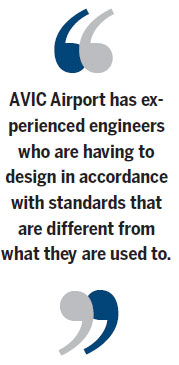What happens when different companies from different parts of the world, used to using different standards, get together to build a major expansion and upgrade to one of Africa's premier airports?
In the case of the international airport serving Nairobi, Kenya, it has been a feat of hard work, debate, learning and, ultimately, pride in achievement. It has been a first for the engineers of Beijing-based AVIC-Intl Airport Construction.
On March 9, 1958, Jomo Kenyatta International Airport, formerly called Embakasi Airport, was opened by the last colonial governor of Kenya.
The airport was renamed in honor of former Kenyan prime minister and president, Mzee Jomo Kenyatta, after his death on Aug 22, 1978. It is Kenya's largest aviation facility, and the busiest airport in East Africa. Its importance as an aviation center makes it the pacesetter for other airports in the region.
Today, Jomo Kenyatta International serves a daily average of 19,000 passengers from Africa, Europe and Asia. Currently the airport cannot meet the growing air traffic needs.
The groundbreaking of a new passenger terminal dubbed the "Greenfield Terminal", with a capacity of 20 million passengers, was held on Dec 3, 2013. It is set to be the single largest terminal in Africa and is to be completed in 2016. The estimated cost is $654 million.
Once complete, the terminal will have 60 check-in positions and 32 contact points and eight remote gates. The terminal is also expected to have an automated baggage handling commercial retail center.

It will have a traffic-handling capacity of 3,133 international passengers, 2,403 transiting passengers and 845 domestic passengers in a typical peak hour. The airport will have an official capacity of 2.5 million passengers but handles an average of 6.5 million passengers every year. Traffic at the airport grows at a rate of 12 percent per annum and is expected to hit the 25 million mark by 2025.
The engineers for the project, including on landside and the airfield side, are from AVIC Airport of Beijing. The architects for the terminal are Pascall+Watson, a London-based firm. Construction of the new terminal will be done by Anhui Civil Engineering Group and China National Aero-Technology International Engineering Corporation. The project supervisor is the Louis Berger Group, a US-based firm.
This is a challenging and interesting project for AVIC Airport. It is the first time the firm has designed an airport based on British/Euro standards. There are many Chinese firms doing construction work in Africa, but not design.
AVIC Airport has a tight time frame for this project. It started the design work in September 2014. Because of the tight project schedule, AVIC Airport engineers have worked overtime on this project, trying to complete the design work on time, under budget and with satisfaction.
AVIC Airport has experienced engineers who are having to design in accordance with standards that are different from what they are used to. This combination of different companies accustomed to using different systems means issues sometimes have to be hashed out.
AVIC engineers, for example, disagreed with Pascall+Watson over the "building gross area" because the way to calculate it is different in British/Euro standards and Chinese standards. In order to be compliant with British/Euro standards and local engineering practices and regulations, they have visited the Kenya Meteorological Department, the Ministry of Transport and Infrastructure, local engineering firms and universities and discussed the design issues with British firms.
AVIC Airport also has had to face unfamiliar design approaches and requirements of design depth in different stages. For example, "30 percent design" was confusing to AVIC engineers because they never use the terminology "30 percent design". They mistook it for "conceptual design", with a few drawings and general notes.
Different engineering expressions on the drawings were another challenge. They have their standard ways to put designs on the drawings. The site condition, local geotechnical conditions, materials available and costs also challenged AVIC Airport's design work.
AVIC engineers have had a lot of pressure on them, but they seem to enjoy the work and have made progress every day. The sense of achievement in overcoming challenges has encouraged the engineers.
The author is an international airport expert based in the US.
(China Daily Africa Weekly 01/30/2015 page9)